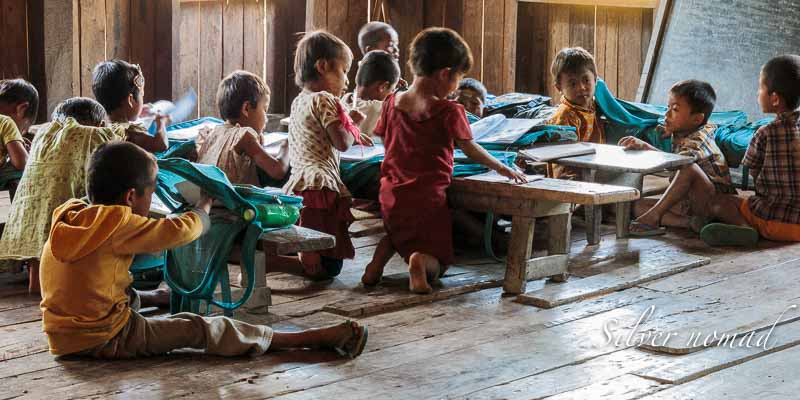The mind once enlightened cannot again become dark.
Thomas Paine
I’ve visited quite a few schools in Asia and they consistently take my breath away. I am always astounded at conditions in rural Asia and that anyone learns to read and write at all. But they do. According to UNESCO, the Youth Literacy rate in Myanmar is 96 percent. Youth Literacy is defined as young people between the ages of 15 to 24 who can read, write and understand a simple statement about everyday life.
How teachers teach and children manage to learn in some of the poorer schools is astonishing.

The schools in the Chin villages were amongst the poorest I’ve seen and quite a shock after the International schools in Asia where I consulted every winter for twelve years. International schools were originally set up to educate the children of ambassadors and executives of large companies who were working overseas and would eventually return to their country of origin. There is a network of these schools all over the world and nowadays they serve not only the children of traditional expatriates but also the children of the wealthy in the host country. The facilities themselves are stunning and the resources available to teachers and students simply amazing.
In the first Chin village we visited, the school for the teenagers (I am loathe to say high school) was a hut in the centre of the village. It was easy to identify by the number of flip-flops lying outside – and by the noise.

The hut was alive with the buzzing of teenagers. Algebraic equations were on the chalkboard but Algebra was clearly the last thing on their minds. There seemed to be no adult in charge: whoever had demonstrated the equations was no longer around.

The students were sitting or kneeling in Myanmar-style on the floor, in front of desks that were very low to the floor. Most students seemed to have paper and pencils but no other resources, except the chalkboard with the mysterious equations, were evident.

The school for younger students was at the end of the first Chin village. It was a substantial building but I felt sorry for the young female teacher trying to instruct children who seemed more interested in fixing their hair than in learning.

The children were a cheery bunch – but a handful for one young teacher to work with. There was only paper and pencil as resources for learning and none of the visual aids – computers, smart boards, TVs or the rest of the paraphernalia – that western teachers have access to.



In the second Chin village, the senior school seemed more orderly with a teacher writing the exquisite Burmese script on the chalkboard. He also went round and sat with small groups of students while they worked.




The Burmese or Myanmar script was developed from a southern Indian script in the eight century. Originally the script was square-shaped but rounded letters developed in the seventeenth century as a result of using palm leaves to write on: straight lines would have torn the leaves. It is a syllabic alphabet, which means each letter has an inherent vowel.
(I previously came across a syllabic alphabet when I was teaching in the Eastern Arctic forty odd years ago. Inuktitut, the language of the Canadian Inuit or Eskimos as they used to be called, is written using syllabics).
The Burmese alphabet consists of 33 letters and twelve vowels. It is written left to right and no spaces are required between words. It is a tonal language and diacritical marks are used in the written language. Here are the numbers written in Myanmar.

And here’s an example of the beautiful script..

And here is the translation.

And here is a short video that demonstrates the shapes of the letters with their sounds.
One advantage of a syllabic alphabet is that if you know the language and learn the orthography, you can write anything you can say. This is definitely not the case with English and its haphazard (almost) spelling.
I enjoyed my visit to the Chin ladies but left thinking that if Education is the route to a more prosperous life, as we are so often told, what will become of the younger generation. School seemed so inconsequential to many of them. Most seemed destined to be chained to life in their village with its round of chores to support a subsistence level of living.
And so I found yet another reason to be glad I was educated in Britain on the heels of the 1944 Education Act, which ensured that all children, irrespective of social or financial background, got a fair shake at an education.
Privacy Policy


